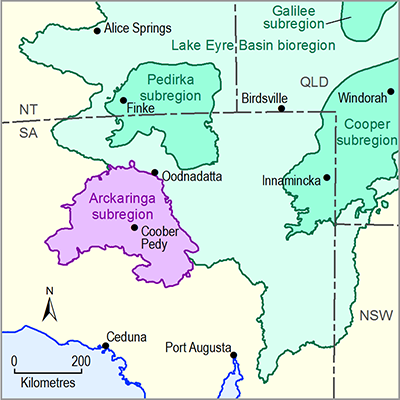The Arckaringa Basin contains thick, extensive Permian coal measures comprising a number of discrete deposits within the upper Mount Toondina Formation. In total, seven major deposits of largely lignite A/subbituminous C rank coal have been measured, indicated or inferred within the Arckaringa Basin (DMITRE, 2012; Figure 20 and Table 5). These deposits are composed of multiple seam, with individual seams up to 10 m thick and cumulative thickness of up to 35 m. Recently, Geoscience Australia and Bureau of Resources and Energy Economics (2014) calculated that total recoverable black coal resources in the Arckaringa Basin amounted to 13 730 Mt. Inclusive in this figure was 623 Mt of economic demonstrated resources (EDR), 3635 Mt of sub-economic demonstrated resources (SDR) and 9472 Mt of inferred resources. Based on palynological studies, the age of the coal units within the upper Mount Toondina Formation is Late Sakmarian (Early Permian) deposited around 290 Ma (Alley, 1995; Menpes, 2012). With respect to coal seam gas, DMITRE (2012) suggested the grade of coal seams as currently understood is not sufficiently mature to have generated significant thermogenic gas volumes. However, potential connectivity with the overlying Algebuckina Sandstone may allow for biogenic coal seam gas generation. In contrast SAPEX (2007) provided an initial estimate of between 0.207 to 1.1 trillion cubic feet (cf) of coal seam gas contained within the Wintinna East coal deposit.
The occurrence of coals is interpreted to have been controlled by syn-depositional faulting described in Section 1.1.3.1, which influenced the amount of accommodation space available in depocentres for coal deposition. Post-depositional erosion may have removed coal-bearing sequences from the far northern and north-western parts of the basin and shallower parts of the southern basin (DMITRE, 2012).
Table 5 Summary of known major coal occurrences in the Arckaringa subregion
Source: DMITRE (2012), Jami and Ray (2007), Huleatt (1991) and SA Coal (2010)
With respect to other hydrocarbon plays, the Arckaringa subregion is also subject to conventional hydrocarbon and shale oil exploration. Trace hydrocarbons have been found within sandstone units of the Mount Toondina and Boorthanna formations with analysis of oil samples suggesting a pre-Permian source. Additionally, organic-rich marine shale within the Stuart Range Formation, particularly within the Boorthanna and southern Arckaringa troughs, have been identified as potential unconventional shale oil plays (DMITRE, 2012). Work is ongoing to identify sedimentary packages within a sequence stratigraphic framework, with a particular focus on understanding the distribution of organic-rich shale within the Stuart Range Formation (DMITRE, 2012).
Additionally, the Officer and Warburton basin has also been the subject of exploration for conventional petroleum hydrocarbons. DMITRE (2012) suggest that both the Warburton and Officer basins are prospective for tight gas resources and that the Warburton Basin is also prospective for shale gas. With respect to the Warburton Basin, prospectivity is mostly found in the vicinity of the Cooper Basin.
Figure 20 Defined coal resources of the Arckaringa subregion

Product Finalisation date
- 1.1.1 Bioregion
- 1.1.2 Geography
- 1.1.3 Geology
- 1.1.4 Hydrogeology and groundwater quality
- 1.1.5 Surface water hydrology and surface water quality
- 1.1.6 Surface water – groundwater interactions
- 1.1.7 Ecology
- Citation
- Acknowledgements
- Contributors from the Government of South Australia
- Contributors to the Technical Programme
- About this technical product

